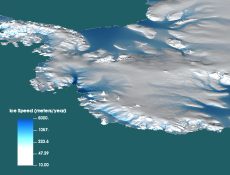Projected Land Ice Contributions to Sea Level Rise
May 5, 2021

This image shows the rate of ice movement according to the models for the year 2100 in one of the climate scenarios considered in the Nature paper.
Science Achievement
Holding global temperature rise to no more than 1.5 degrees C – rather than following current emissions pledges – could halve the sea level rise from melting land ice by the year 2100, according to research published by an international team of scientists in the journal Nature. The study updates previous ones using the latest socio-economic scenarios and a coordinated exploration of uncertainties in the models.
Significance and Impact
Melting land ice has contributed around half of all sea level rise since 1993, and this fraction is expected to increase. The Ice Sheet Model Intercomparison Project (ISMIP6) for Coupled Model Intercomparison Project Phase 6 (CMIP6) provides the Intergovernmental Panel on Climate Change (IPCC) with projections of Earth’s ice sheet contributions to future sea level.
Research Details
The project uses suites of numerical models and greenhouse gas emission scenarios as the basis of their projections, and various treatments are considered for the interaction between the ice sheets and the ocean. A team led by Stephen Price and Esmond Ng used the Los Alamos, Sandia, and Berkeley Lab-developed MALI and BISICLES ice sheet models as part of the study and were run on NERSC supercomputers.
Related Links
Edwards, T.L., Nowicki, S., Marzeion, B. et al. Projected land ice contributions to twenty-first-century sea level rise. Nature 593, 74–82 (2021). https://doi.org/10.1038/s41586-021-03302-y
About NERSC and Berkeley Lab
The National Energy Research Scientific Computing Center (NERSC) is a U.S. Department of Energy Office of Science User Facility that serves as the primary high performance computing center for scientific research sponsored by the Office of Science. Located at Lawrence Berkeley National Laboratory, NERSC serves almost 10,000 scientists at national laboratories and universities researching a wide range of problems in climate, fusion energy, materials science, physics, chemistry, computational biology, and other disciplines. Berkeley Lab is a DOE national laboratory located in Berkeley, California. It conducts unclassified scientific research and is managed by the University of California for the U.S. Department of Energy. »Learn more about computing sciences at Berkeley Lab.







